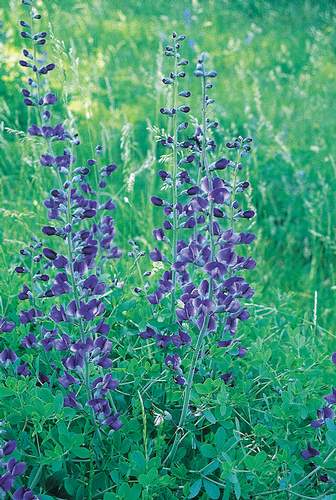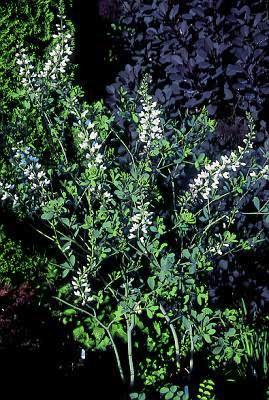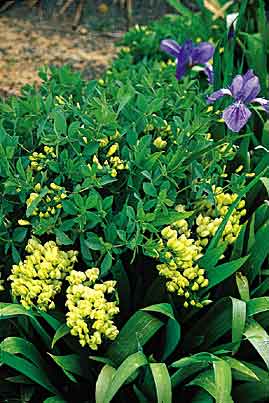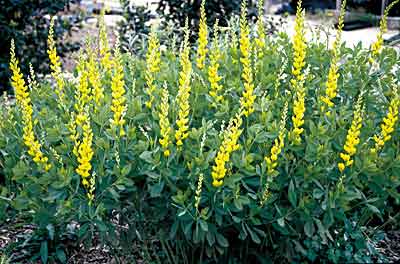| ||||||||||||||||||||||||||||||||||||||||||||||||||||||||||||||||
|
Baptisia - Revenge of the Redneck Lupinesby Tony Avent for Horticulture Magazine, June 2002Please forgive me, but I'm in my baptisia phase. Plant lovers understand all about phases...we move from one plant group to another, studying and collecting everything in sight. My love for baptisias began many years ago, but it was in 1994 that I went off the proverbial deep end for this group of glorified peas. Perhaps it was my numerous attempts to grow their sister genera, the lupines, of which I always failed outright or rendered them so ugly that a mercy killing was necessary. All the while, my baptisias were thriving only a few feet away.What is it about baptisia that folks love? Perhaps it is their spiky architectural form, especially as they emerge, that garners favor among gardeners. I cannot imagine a more perfectly formed specimen perennial than a well grown baptisia. In the perennial border, baptisia has few equals, again for it's form and ability to serve as a focal point in spring, then as an attractive space filler during the summer.
I like to use baptisia as specimen plants where their structural form can be appreciated. To do this, they should be planted among groundcovers that highlight their best attributes. Some of my favorites subservient plants for baptisia include Artemisia 'Powis Castle', Veronica 'Sunshine', V. 'Aztec Gold', or V. 'Georgia Blue'. I like to play yellow against blue, so choose your color of groundcover according to your choice of baptisia. The silver foliage of the artemisia nicely echos the blue in the baptisia foliage. I try to plant the artemisia several feet away from the base of the baptisia so that only the outer branches surround the base of the baptisia. Other groundcovers that serve as a perfect foil for baptisia include Iris tectorum, which usually coincides with mid-spring baptisia flowering and any of the gold foliage acorus...provided the ground doesn't get too dry in summer. Baptisia also make a perfect companion for early spring flowering bulbs, as they can be timed so that their stalks emerge just after the bulbs have finished. Baptisias develop such a thick canopy of foliage that it would be hard to achieve a simultaneous display of bulbs and baptisia in the same space, but as a successionary planting, they are hard to beat. When I began my quest, finding many baptisia other than Baptisia australis was not easy. After a bit of searching, I was able to obtain B. pendula (now B. alba var. alba), B. alba (now B. albescens), and B. viridis (now B. sphaerocarpa). Soon after this, I saw two of the more distinctive species, B. arachnifera, at the JC Raulston Arboretum, and B. perfoliata, at the garden of garden writer Pam Harper; I knew I had to have them all. First came the research phase, which culminated in my discovery of the Baptisia monograph (family history), published in 1940 by the late botanist Mary Maxine Larisey. The monograph was particularly good, since it furnished descriptions of each species as well as location maps and directions to each population. By the end of 2001, I had made 17 trips across the U.S. to find and collect baptisia specimens. You may find it strange that plants documented from the 1930's could still be found in their original locations, and indeed that is the exception rather than the rule. Fortunately, baptisias are primarily scrub and prairie natives; areas now used for livestock production or military bases. Since baptisia are unpalatable to livestock, many of our best specimens are from the midst of gigantic pastures. Many farmers have fortunately given up trying to rid their field of these "weeds". I have certainly tried to do my part to help, and have more than one un- intentional barbed wire tattoo to remind me. As they say on television, do not try this at home. While baptisia rustling isn't on the same level as bungi-jumping from an airplane, I can attest that being stopped by an unhappy Texas rancher with a fast four-wheel drive and a really big gun is not for the faint of heart. Baptisia species come in three flower colors: blue, white, creamy yellow and bright yellow. Now that natural hybrids are being discovered as well as intentional crosses made, it won't be long before we see reds and pinks joining the mix. Although the blue species are most well known in gardens, they are in actuality the rarest color in the genus. The Blue Flowered SpeciesThe most commonly grown baptisias is Baptisia australis. While Baptisia australis is certainly a garden worthy plant, it is far from being the star of the genus. Native to river banks from Vermont south to the Shenandoah Valley, B. australis is one of the larger species, making a 3' tall x 5-6' wide mound of glaucous blue-green foliage. The flower spikes emerge intact atop the newly emerging foliage in mid-April. By late April, the flowers begin to open, ranging from a good blue to purple color, with each seed grown plant being different. Most seed strains of B. australis produce large flower spikes which, like a good drunk can become a bit wobbly with age.I find the best of the blue flowered species to be Baptisia minor. B. minor is virtually unknown commercially, because taxonomists decided that it was no different than B. australis. Taxonomists still argue about the proper classification of B. minor. Some now call it a subspecies of B. australis, while others elevate it to species status. The disjunct east coast remnant populations are named B. minor v. aberrans, while the Midwest prairie native populations are named B. minor var. minor. Obviously, anyone who has studied Baptisia minor in the wild realizes that this species is indeed remarkably different from Baptisia australis. B. minor makes a much smaller plant, rarely exceeding 18" tall. The leaves are much smaller, presenting a much more lacy texture. The beauty of B. minor is the 12-18" tall spikes of blue or lavender flowers. I have also never seen B. minor get "lazy" flower spikes like B. australis. I enjoy B. minor in seed as well, since the huge pods turn a magnificent pure black when mature. One of my most exciting baptisia finds came from a population here in NC. A botanist friend Craig Moretz took me to a remote population where we found three pink flowering plants of Baptisia minor. We were successful in propagating these from cuttings and now have them on trial.
The White Flowered SpeciesThe white species have suffered from being taxonomically muddled. Due to errors in the original 1940 monograph, incorrect names have made their way into the trade and have left gardeners wondering exactly which white baptisia they are growing. The most commonly seen names are Baptisia alba, Baptisia leucantha, and Baptisia pendula. When the smoke from the taxonomist guns had cleared, B. alba became B. albescens; B. leucantha became B. alba var. macrophylla, and B. pendula became B. alba var. alba. The white flowered species are much later flowering than most of the blue or yellow flowered species, with only a few exceptions.Baptisia alba var. macrophylla (formerly B. leucantha) has a huge native range, native from Minnesota south to Tennessee. It is also one of the tallest species, ranging from 5-7' tall. Although each clump doesn't produce many flower spikes, the ones that are produced are stunningly beautiful. Baptisia alba var. alba (formerly B. pendula), or thick pod wild indigo, is the southeastern form of B. alba. It is easily recognizable from B. alba var. macrophylla (B. leucantha) due to it's large black pendant seed pods and shorter stature to 3-4' tall. It is native scattered throughout the southeast from NC to Florida. A third white species is the southeastern native, Baptisia albescens (formerly B. alba), ranging from Tennessee to Florida It is prized as a great garden plant, both for its smaller stature, usually 4' tall or less, and numerous, often colored charcoal-black, long racemed flower stalks. It can be distinguished from the other white flowered species by its narrow seed pod that turns tan when dry instead of black. A Baptisia albescens specimen that I found in central NC was growing 7' tall on a dry road bank...just imagine what it would do in good garden conditions.
The Creamy Yellow Flowered SpeciesOne of my favorites is the little known Baptisia bracteata. Baptisia bracteata is often divided into two varieties: Baptisia bracteata var. bracteata and Baptisia bracteata var. leucophaea (syn: B. leucophaea). Baptisia bracteata var. leucophaea, considered by some taxonomists to be a full fledged species, occurs from Texas north to Minnesota. B. bracteata var. bracteata is its southern counterpart and only occurs from NC south to Alabama.All members of the "bracteata" group are very early flowering baptisias, often starting in late March to early April in NC. Instead of having upright flower stalks, they emerge horizontally like giant clusters of creamy-yellow grapes. Many regional forms of B. bracteata var. leucophaea emerge with a dark purple cast to the new foliage that disappears as they come into flower. There are many other pale yellow flowered species, but most have little floristic garden merit except to plant collectors. Some have unique foliage, such as B. lanceolata, but the axillary flowers don't make much a show compared with their better endowed cousins.
The Bright Yellow Flowered SpeciesIt's easy to agree on the best of the yellow species, Baptisia sphaerocarpa. It's actually hard to find any other Baptisia that has as much flower power as this native, found from Texas to Missouri. Not only is it particularly showy, but I have found this species in the wild in dry sand as well as growing in wet swales.While Baptisia sphaerocarpa (aka: B. viridis) looks great in mass in the wild, this is only a shadow of what the plant will become when given some tlc in the garden. We have single specimens that attain a height of 2' with a spread of 4' and produce over 130 flower spikes at once! When they come into flower in mid-April with their bright yellow flowers, it's truly a Kodak moment. Baptisia sphaerocarpa produces very distinctive, perfectly round marble-size seed pods, unlike most other species with more finger-like shaped pods. While none of the other yellow species are as showy in flower as Baptisia sphaerocarpa, there are certainly some that stand out for their foliage. In particular, Baptisia arachnifera and Baptisia perfoliata. Both are southeastern natives with foliage that resembles eucalyptus instead of baptisia.
The rare Georgia native Baptisia arachnifera is so rare that it has been declared a Federally Endangered Species. If you can manage to find nursery propagated Baptisia arachnifera for your garden, select an open spot in the rock garden for best performance. Baptisia arachnifera has round silvery webbed foliage that looks great all season. We even test keen visitors to our display garden, and at least 99% come back with an identification of eucalyptus. Baptisia arachnifera rarely exceeds 15" in height. The inconspicuous small yellow flowers appear in the leaf axils in August. Baptisia perfoliata is another unique foliage specimen. This glaucous green foliaged southern endemic to a couple of southern highways, in particular Interstate 20 in South Carolina and Georgia, is also often mistaken for eucalyptus. Clumps of Baptisia perfoliata can get much larger, eventually making a 30" tall x 3' wide clump of amazing foliage. The April produced yellow flowers are also axillary, but the really cool effect is the small round seed pods that dry next to the leaf. The foliage of B. perfoliata turns brown in late summer, leaving you a clump of amazing brown eucalyptus- looking stems with round pods by each leaf. This a unique garden addition with tremendous floral arrangement possibilities. For small spaces, the NC/SC sandhills and coastal plain native, Baptisia cinerea is a great choice, but one that is often overlooked. It resembles a short Baptisia bracteata var. leucophaea that rarely exceeds 1' in height, and is adorned with horizontal flower panicles of bright yellow in early spring...usually April. Two other quirky species are fun, if not showy for the garden. Baptisia tinctoria is probably the most widespread species, ranging from Minnesota south to Georgia. The small foliage and equally small terminal spike of yellow flowers are described as not showy by most garden writers. In reality, with a little selection for foliage and flowering characteristics, Baptisia tinctoria could easily become a garden standard. The small foliage creates a delightfully airy clump, in contrast to the bold texture of most baptisias. The other truly unique member of the genus is Baptisia simplicifolia. This Florida endemic has not only proven reliably hardy in zone 5, but it has the strange habit of not emerging before mid-June. While this is understandable for anything in zone 5, it makes no sense for a plant from Florida. Once it does emerge, the glossy green foliage looks completely un-baptisia like. Baptisia simplicifolia is topped with terminal spikes of yellow in mid to late July in our garden. There are plenty more yellow flowered species, all of which are strangely restricted to the southeastern US. We are currently evaluating them for garden worthiness, but short of a few surprises, we have described the best. Selections and HybridsConsidering the worldwide proliferation of cultivars, there are still no named selections of Baptisia species in the trade. Only one, which has not yet hit the market in a large scale is Larry Lowman's Baptisia sphaerocarpa 'Screamin' Yellow', which is slightly shorter than the other forms that we grow. We have spent quite a bit of time studying baptisia in the wild, and find this lack of introductions bewildering. We have recently made cuttings from selections in the wild, rooted them, and planted them for evaluation. This allows us to evaluate clones from around the country in a side-by-side comparison. Once evaluations are complete, then those selected for introduction will be named, propagated, and marketed.While there are no selections of species on the market, there are beginning to be a few hybrids to enter the trade. As I mentioned earlier, I feel that there are indeed many hybrids present in gardens that are masquerading as species. In reality, most of these hybrids are not improvements on the native species. There are, however, the rare exceptions of a hybrid that is better than the parents, such as two introductions from Rob Gardner at the NC Botanical Garden in Chapel Hill, NC. With an extensive baptisia collection at the garden, it should not be surprising that some horticultural hanky-panky would be going on there. Their amazing first introduction was a cross between Baptisia minor and Baptisia albescens, which was given the name of Baptisia 'Purple Smoke'. The hybrid was indeed much better than the parents. Baptisia 'Purple Smoke' picked up the tall black flower stalk from Baptisia albescens and the purple flower color from Baptisia minor. The second of the NCBG releases, introduced in 2002, is Baptisia 'Carolina Moonlight', a cross between Baptisia sphaerocarpa and Baptisia albescens. This amazingly vigorous and fast growing plant has upright spikes of light buttery yellow and is the first baptisia with creamy yellow flowers held on anything other than a pendulous spike. Well grown plants of either of these hybrids will hold their own against any lupine, and in time, will far bypass them in duration. I am still amazed that Baptisia hybrids have not hit the market before now, but this again shows the lack of communication between botanists and horticulturists. In my early research, I read about a group of naturally occurring baptisia hybrids were documented in Oklahoma and Texas as early as the late 1930's. After tracking down a publication from 1996 that showed color pictures of these same bicolor hybrids (blue and yellow and red and yellow), I was on the phone to the authors of the papers in Texas. When I informed them that I wanted to visit and take cuttings for propagation, I was told that the plants had been accidentally sprayed with weed killer the year prior by the landowner. But, the botanists proudly proclaimed, "We have dried herbarium specimens". How did these plants escape being propagated, while being known for 60 years? On the bright side, we have since found a number of naturally occurring hybrid populations and have taken cuttings of some that have some great garden potential, although none as spectacular as the lost Texas populations. PropagationPropagation of baptisias is relatively easy once you understand a bit about the plants. Most baptisias in the US are propagated from seed. This is fine as long as the seed blocks are isolated, but rarely is this the case. As a group, baptisia are very promiscuous in the garden...at least with other baptisia. I'll bet that if all the Baptisia australis in gardens was DNA tested, few would be found as the true species. I remember ordering the creamy white Baptisia megacarpa for years, but always receiving blue flowered plants. It was simply a matter of nurseries collecting seed that had hybridized in a garden. To this end, one of our missions has been to offer plants from wild collected seed sources, ensuring and providing correctly named plants.Fresh sown baptisia seed germinates quite easy and quite fast...usually in two weeks. Old stored seed, on the other hand is very difficult and slow to sprout. I recommend that all old baptisia seed be placed in a Styrofoam cup and doused in boiling water and allowed to cool prior to planting. This will begin to break down the seed coat and encourage germination. We have even tried this on seed that was sown but showed sporadic germination. Un-germinated seed were sifted from the potting mix, drenched with boiling water, and resown, with amazing results. Another propagation method that is a fairly recent development for baptisia, is stem cuttings. Most baptisias root easy in spring when the growth is soft, the success rate drops off to zero as the plants harden. Cuttings should be dipped in a rooting hormone, and then kept in high humidity until they root...usually about 8 weeks. Another problem with cutting propagated baptisias is one of overwintering. If the cutting grown plants do not develop enough starches after they root, they will not form new growth buds for the following spring. In spring, a mass of roots will simply fail to send up any foliage. We have found that after rooting, plants that are placed directly into the ground seem to develop growth buds faster than container grown plants. The other option is to keep newly rooted containerized plants in a warm greenhouse or on a windowsill until the new buds develop at the base, and they can be allowed to go dormant. New advances such as tissue culture propagation of baptisias has done wonders to increase numbers more rapidly and overcome some of the overwintering issues that we have faced with conventional cuttings. Winter hardiness is, indeed, one of the great surprises about baptisia is that they all seem to be winter hardy through zone 5, and possibly further north. Both Brian McGowan of Blue Meadow Farm in Massachusetts and Hans Hansen of Shady Oaks Nursery in Minnesota have performed trials on many of the southern species with amazing success. We are currently working with a number of keen gardeners and researchers around the country who also are breeding and selecting baptisias. Selections are being made for size, for stem color, for flower color, and even flowering season. It will only be a matter of time before nurseries will be offering dramatically improved selections of Baptisia. Who knows, maybe we'll meet at the first baptisia...I mean Redneck Lupine Society meeting in a few years. Baptisia Flowering Chart
Be sure to visit our on-line catalog for a listing of available baptisia, with links to plant descriptions and great pictures. | |||||||||||||||||||||||||||||||||||||||||||||||||||||||||||||||
|
Copyright © 1997-2025 Plant Delights Nursery.Inc. Graphic Art Copyright © 1997-2025 Jack Pittman Site Designed and Maintained by Cyberlily Webdesign. This page last updated on 07/19/2010. | ||||||||||||||||||||||||||||||||||||||||||||||||||||||||||||||||



 Perhaps it is their amazing drought tolerance and ability to withstand the ravages of
nature that attracts many gardeners to baptisias. I'll never forget one of my early baptisia trips to
northern Texas during the first week of August. Weather reports lamented 50 consecutive days
over 100 degrees, and no rain for over six months. I wasn't sure if there would be any baptisia
left, but once I arrived, it was truly amazing to find the baptisia in the wild looking as good as
they would have in a well watered garden, with full seed capsules intact.
Perhaps it is their amazing drought tolerance and ability to withstand the ravages of
nature that attracts many gardeners to baptisias. I'll never forget one of my early baptisia trips to
northern Texas during the first week of August. Weather reports lamented 50 consecutive days
over 100 degrees, and no rain for over six months. I wasn't sure if there would be any baptisia
left, but once I arrived, it was truly amazing to find the baptisia in the wild looking as good as
they would have in a well watered garden, with full seed capsules intact.










